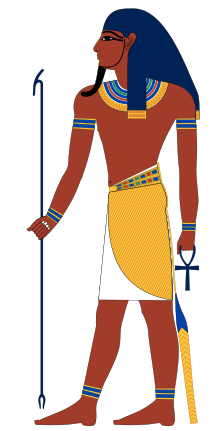
Back Atoem Afrikaans Atum ALS أتوم (إله) Arabic اتوم (اله) ARZ Atum Azerbaijani Атум Byelorussian Атум Bulgarian আতুম Bengali/Bangla ཨ་ཐུན། Tibetan Atoum Breton
| Atum | ||||
|---|---|---|---|---|
 Atum is shown as a man with a was-scepter to show his power, and an Ankh to symbolize his ability to grant life. He is later often shown with the Double Crown. | ||||
| Name in hieroglyphs |
| |||
| Major cult center | Heliopolis | |||
| Genealogy | ||||
| Consort | Iusaaset[1] or Nebethetepet[2] | |||
| Children | Shu and Tefnut | |||
Atum (/ɑ.tum/, Egyptian: jtm(w) or tm(w), reconstructed [jaˈtaːmuw]; Coptic ⲁⲧⲟⲩⲙ Atoum),[3][4] sometimes rendered as Atem, Temu, or Tem, is the primordial God in Egyptian mythology from whom all else arose. He created himself and is the father of Shu and Tefnut, the divine couple, who are the ancestors of the other Egyptian deities. Atum is also closely associated with the evening sun. As a primordial god and as the evening sun, Atum has chthonic and underworld connections.[5] Atum was relevant to the ancient Egyptians throughout most of Egypt's history. He is believed to have been present in ideology as early as predynastic times, becoming even more prevalent during the Old Kingdom and continuing to be worshiped through the Middle and New Kingdom, though he becomes overshadowed by Re around this time.
- ^ Wilkinson 2003, p. 150.
- ^ Wilkinson 2003, p. 156.
- ^ "Coptic Dictionary Online". corpling.uis.georgetown.edu. Retrieved 2017-09-21.
- ^ "Thesaurus Linguae Aegyptiae". Berlin-Brandenburg Academy of Sciences and Humanities. Retrieved 2017-09-21.
- ^ Richard H. Wilkinson (2003). The complete gods and goddesses of ancient Egypt. Internet Archive. Thames & Hudson. pp. 98–101. ISBN 978-0-500-05120-7.